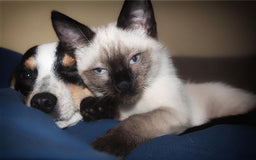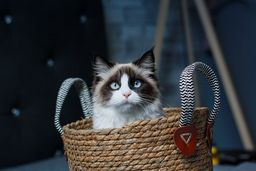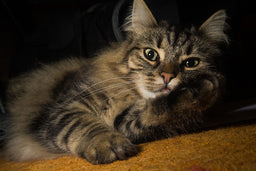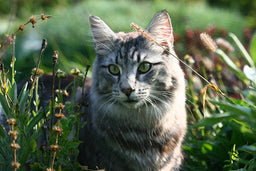Does a shorthair Ragdoll cat exist? Let’s split hairs and find out!
What makes a cat a true Ragdoll? Is it the piercing blue eyes or the trademark friendly attitude? Yes, and yes, but also—the feline’s signature fluffy coat!
The gentle giants are considered a semi-longhaired breed, akin to the mighty Maine Coons. But does that mean a shorthair Ragdoll cat doesn't exist?
If you want to know more about the lovely Ragdoll cat’s fur characteristics, you’ve come to the right place. We’re looking into the notable attributes of the floppy cat’s lovely fur and answering questions like:
- Can Ragdolls have short hair?
- Do Ragdolls need to be groomed?
- How do you maintain a Ragdoll’s fur?
Can a Ragdoll cat have short hair?
According to the Governing Council of Cat Fancy—the UK’s preceding cat registration body—Ragdolls are a semi-longhaired breed. The fluffy felines don’t have short coats unless they were mixed with another breed.
Does that mean all shorthair Ragdoll kittens are crossbred? Not necessarily. Like most cats, Ragdolls are born without fur and grow their coat over time. A shorthair Ragdoll kitten is a common sight since it takes them 3–4 years to fluff up fully. Besides “sporting a buzzcut,” newborn kitties typically have a white coat that can change colours as they mature.
If you run into a full-grown shorthair Ragdoll cat, they’re most likely crossbred. The raggedy cats are often mixed with British Shorthairs since they’re another popular breed in the UK.

If you have a shorthair Ragdoll, it was probably mixed with another cat!
Source: @ragdollcats_lover
What type of fur do Ragdolls have?
A Ragdoll’s fur has a beautiful silky texture, similar to that of a rabbit. They have lion-like hair riffs in the neck and chest area, akin to other long-haired felines (e.g. Maine Coons), and gorgeous fluffy tails. The traditional Ragdoll colours and other notable characteristics are summarised in the table below:
|
Category |
Breed characteristic |
|
Fur length |
Semi-long |
|
Seal, blue, chocolate, lilac, red, and cream |
|
|
Patterns |
Bicolour, mitted, colourpoint, lynx, tortoiseshell |
|
Eye colour |
Blue |
Are Ragdoll cats hypoallergenic?
Since Ragdolls aren’t fully long-haired, they are often mistakenly labelled as hypoallergenic cats. They also don’t have an undercoat, which adds to the confusion. Longhair or not, Ragdoll cats still produce Fel D1—the allergen responsible for skin irritations and allergy-induced asthma in sensitive people.
While they tend to have less dander than long-haired breeds with thick undercoats (e.g. Maine Coons or Persians), Ragdolls can still cause allergic reactions. During shedding season, the fluffy cats carry allergens in both their hair and saliva due to increased grooming.
If you are allergic to cats, a Ragdoll isn’t the right pick for you. The clingy feline will be all over you, asking to be coddled. You should consider getting a hypoallergenic breed, like a Russian Blue, Burmese, or Sphynx cat.
Do Ragdolls need grooming?
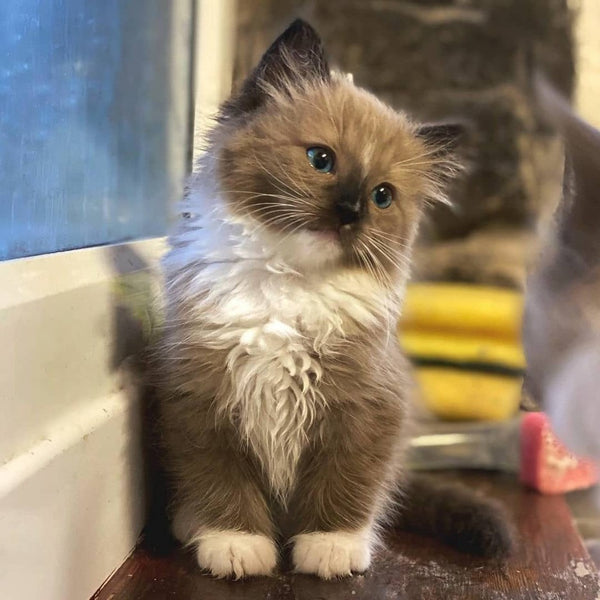
The little fluffballs need weekly brushing!
Source: @ragdollcats_lover
Ragdolls aren’t particularly high-maintenance when it comes to grooming, especially while their fur is still short. Since they don’t have a dense undercoat, their fur doesn’t have to be groomed each day. They also spend most of the time in the house and are less likely to get dirty than outdoor pets.
A Ragdoll’s hair isn’t prone to matting, but that doesn’t mean it doesn’t need basic care. If you neglect their fur, it can get tangled, especially during shedding season.
To make sure your fluffy cat remains fluffy, you should:
- Brush the fur at least twice per week
- Use a slicker brush instead of one with steel bristles to avoid accidental scratches
- Focus on the areas with longer fur first
- Brush in upward movements to avoid tangling
- Lose the excess dead hair using a rubber brush at the end of grooming
Do Ragdolls need to bathe?
Yes, you should bathe your Ragdoll occasionally. The house cats have good hygiene and are mostly kept indoors, so they don’t need more than one bath per month. Still, the clumsy cat could knock over a potted plant and make a mess that calls for an emergency clean-up.
You should start with monthly or bi-monthly baths at an early age since Ragdolls aren’t that comfortable with water. It also can’t hurt to bribe them with a piece of chicken or another delectable treat!
When bath time comes, make sure to follow these steps:
- Get a plastic container that can accommodate the sizeable cat (you can also use the sink)
- Buy a shampoo that was formulated for Ragdolls specifically. You can wash them with flea-control products, but since they don’t go out that often, a cleansing and deodorising shampoo will suffice
- Use lukewarm water
- Apply the shampoo everywhere except the Ragdoll’s head
- Use a damp towel for the more sensitive areas (e.g. face and ears)
- Do not submerge the feline’s head in water or splash it in their face
- Fill a pitcher with lukewarm water and rinse the shampoo gently. Don’t let the products get in the Ragdoll’s eyes and ears
- Do not use a hairdryer to dry them if the noise frightens them. Dab them with a towel instead
Should you shave a Ragdoll?
If you see a Ragdoll cat with uneven short hair, they most likely suffered a haircut. Some cat parents choose to have their pets shaved to decrease shedding or remove matted fur.
While shaving can affect a Ragdoll’s colour (i.e. it can grow back in a darker shade), it’s mostly harmless. The gentle giants aren’t exposed to direct sunlight or other environmental factors that could hurt their bare skin.
Since a Ragdoll’s fur is so smooth, there are other ways to deal with entanglement. On the rare occasion when the feline’s fluffy fur gets matted, you can try the following:
- Take some coconut oil and apply it to the matted hair
- Let it sit between 50 and 60 minutes
- Get a de-matting tool and start brushing the area. Be careful not to scratch the feline’s skin with the steel bristles
- Use a nail clipper or scissors to trim around the matting if you can’t remove it with a brush
Matting can be quite uncomfortable for a cat, especially if it starts to spread. The entangled hairs can get caught up in various materials and pull on the feline’s skin, causing bleeding and scrapes. Worst case scenario, it could lead to a bacterial infection.
If the matting is out of control, you should consider shaving your Ragdoll.

What are you doing with that razor, Linda?
Source: @ragdollcats_lover
Do Ragdolls shed a lot?
Shedding is a natural occurrence, particularly in medium- to long-haired breeds. All felines go through at least two major sheds per year, to the chagrin of cat parents everywhere. Luckily, even with all that fluff, Ragdolls don’t shed that much—at least not outside the season.
During winter and fall, Ragdolls get a thicker coat to shield them from the rain and snow. As the temperatures rise, they start to lose the extra layer of hair and require more frequent grooming.
If a cat sheds a lot of hair suddenly, it could be due to stress or poor nutrition. Your cat might not be getting enough nutrients in their meals, resulting in dull fur and tented skin.
Long-haired breeds need plenty of moisture, protein, and fatty acids in their diet to maintain their skin and fur healthy.
Glossy fur and healthy skin? Untamed can make it happen!

Shorthair, longhair, purebred, or mix—Untamed is the right choice for your cat.
Image (c) Untamed
Regardless of whether you have a purebred or crossbred Ragdoll, a glossy coat and healthy skin begin with a well-balanced diet, and no one does it better than Untamed—the front runner of a cat food revolution. We produce minimally processed wet food that’s nourishing, hydrating, and delicious. Each Untamed recipe is:
- Rich in protein—One serving holds twice as much animal protein as the industry standard
- Made with whole meat—Our food contains human-grade, natural meat—no artificial flavouring or other questionable ingredients
- Vet-formulated—Each meal is prepared in collaboration with vets
- Ethically made—Untamed meat is ethically reared and sustainably caught
- Fussy eater approved—Your cat doesn't like wet food? The natural aroma of our delicious cat food will turn them around
Because we don’t do sugar, grain, or similar filler, our menu closely resembles the feline natural diet. Unlike dry food and other high-carb products, our recipes deliver nothing but primal nutrients.
Thanks to the feedback from other members of our wild bunch, we’ve mapped out the following health perks of the Untamed effect:
|
Timeline |
The Untamed effect |
|
Within a week |
A few servings of Untamed food should improve your cat's digestion and overall mood |
|
After two months |
Our high-protein food can help minimise seasonal shedding |
|
Within four months |
Your Ragdoll should have fewer hairballs and increased gastrointestinal movement after four months on the Untamed diet |
|
Life-long benefits |
Untamed cats have better weight management, a more efficient immune response, and overall better health |
Spoil your Ragdoll with tailor-made meals
Take our simple online quiz to determine which products work best with your cat's dietary preferences and food sensitivities. Our cordon bleu cuisine for felines features a variety of whole meat recipes with gravy and jelly textures and two hypoallergenic recipes—Chocka Chicken in Jelly and Tuck-in Tuna in Jelly.
You can choose from assorted poultry, fish, and seafood dishes made with the following ingredients:
- Chicken breast
- Chicken liver
- Duck breast
- Salmon fillet
- Tuna steak
- Sardine and mackerel fillet
- Shrimp

Only the best ingredients in our premium cat food!
Image (c) Untamed
How to sign up for a membership
Are you intrigued by our feline delicacies? Sign up for an eight-pound multipack cat food trial box with free shipping! Here’s what you should do:
- Complete the Try Now questionnaire
- Tell us about your pet
- Select the products
- Place the order
The first batch of goodies will arrive at your doorstep in one day’s time. Afterwards, you and your cat will get scheduled deliveries of meal boxes from Untamed every month.
